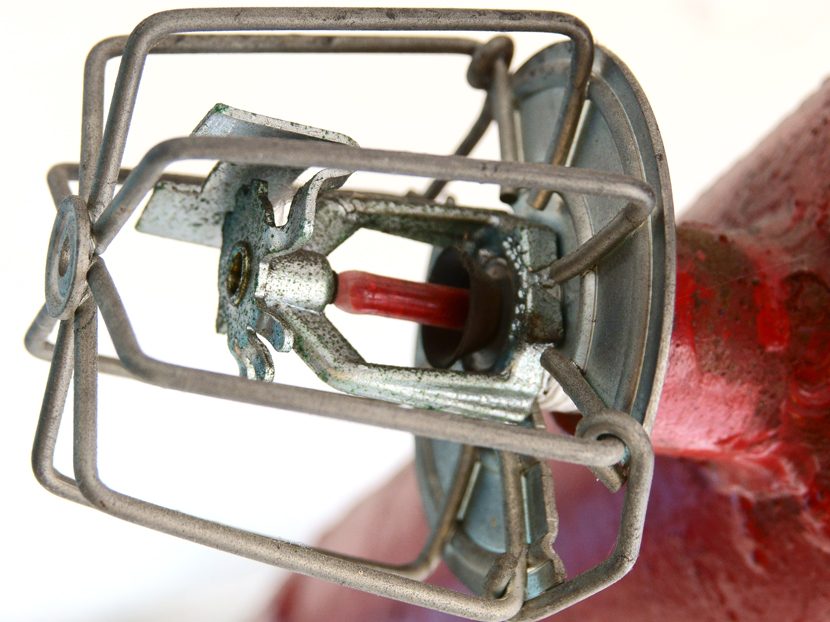Choosing the right sprinkler
Exploring the variables that go into selecting fire sprinkler systems.

Fire sprinklers have been around since the 1800s, with Henry Parmalee often credited with developing the first modern sprinkler to protect his piano factory in Connecticut. Much refinement has occurred since the very first models arrived on the market. Now there are so many options that selecting the best one for a project is not always straightforward.
First, there are three types of configurations for operating sprinklers. One is an open sprinkler. This means there is no operating device and when water flows, it will come through all the open sprinklers. The water flow would be triggered by another device, such as heat detectors.
There are two styles for closed sprinklers. The first is a solder-link model. In this style, the solder is made to melt at a specified temperature, the components clear from the orifice and then water can flow through the sprinkler. The second is a glass bulb sprinkler. Here, a glass bulb is filled with a liquid. A small air bubble expands when heated and bursts the glass bulb at the desired temperature rating. The bulb clears out of the way and the water can flow through the sprinkler.
Fire sprinklers are divided into categories based on their response time index (RTI), a laboratory-measured value that determines how long a fire sprinkler will take to operate under known conditions of hot air moving by the device. The RTI value allows the sprinkler to fall into one of three groups: standard response, special response or fast response.
Very few sprinklers are listed with a special response category. However, there are many models in standard response and fast response. RTI values above 80 (meter-seconds)½ are classified as standard response. Those less than 50 (meter-seconds)½ are considered fast response.
Standard response sprinklers can include standard spray, extended coverage, control mode density area and control mode specific application sprinklers. Fast response sprinklers can consist of quick response spray, extended coverage, early suppression fast response and residential sprinklers.
Each sprinkler has a temperature rating for operation. These are coordinated into ranges that allow the user to select a model accommodating the maximum anticipated ceiling temperature in the space. These ranges allow for a sprinkler to activate quickly when a fire is present but not open unnecessarily in normal working conditions for the space.
Ordinary temperature sprinklers permit for ceiling temperatures up to 100 F. Intermediate temperature sprinklers allow for ceiling temperatures up to 150 F. These ranges continue to increase up to ceiling temperatures of 625 F. Not every model sprinkler is available in every temperature rating, but there are plenty of options to handle most situations.
Style considerations
Next, we can look at style options for sprinklers. There are upright, pendent and sidewall sprinklers, which are named for their orientation of installation. An upright sprinkler is installed above the piping, a pendent sprinkler is connected below the piping and a sidewall sprinkler is mounted to the side of the piping.
Some applications may readily lend themselves to a particular style, such as spaces with drywall ceilings that would rarely use an upright sprinkler as the ceiling also can conceal the piping for aesthetics of the compartment when a pendent is selected. Other applications may be open to choice.
The deflector on each of the different orientations helps to disperse the water over the given area of coverage. When fire sprinklers were first developed, it was thought that a third to a half of the water coming from a sprinkler needed to be thrown to the ceiling to achieve appropriate cooling in the compartment. Now, this type of sprinkler is called an old-style sprinkler.
Through the study of water distribution and testing with different fuel loads, it has been demonstrated that as long as the sprinkler is close to the ceiling (usually considered within 12 inches (300 mm)), all the water can be thrown to the floor and the sprinkler can still control the fire.
In addition to the direction of the water, deflectors also impact the water droplet size as the stream of water from the pipe hits the deflector and breaks apart into droplets. More substantial water droplets can be beneficial in high-challenge fire applications, such as protecting storage. Big water droplets allow travel through the fire’s rising hot gases to reach the fuel so it can be cooled and the fire controlled.
The next variable to discuss with fire sprinklers is the K-factor. This is the measurement of the orifice size in the sprinkler. The K-factor is used to calculate the needed water for the specific sprinkler used. It is determined empirically in a laboratory as it is a relationship between flow and pressure for the particular device.
Nominal K-factor values start at 1.4 [gpm/(psi)½] and go up to 28.0 [gpm/(psi)½]. These nominal values are used in the hydraulic calculations for a fire sprinkler system. The larger the number, the more water that can pass through the outlet. Standards put some limitations on which K-factors can be used for different scenarios, but selecting the best K-factor for the job can help to make a cost-effective system by working with the available water supply.
Most sprinklers are rated to work with pressures inside the pipe up to 175 psi. If a situation presents itself where higher pressures are used within the pipe, then devices, including sprinklers, will need to be rated for higher pressures. High-pressure sprinklers are typically rated up to 300 psi and are readily available.
Existing systems also can be a challenge because many sprinklers may be suitable for a job, and if one has activated and needs replacement, the details of the original sprinkler need to be known. This has led to detailed requirements about maintaining a stock of spare sprinklers. Yet, what happens when there are no spare sprinklers at a specific building?
In 2001, the industry implemented sprinkler identification numbers (SIN). The goal behind the SIN is to have the means to identify the sprinkler and the pertinent characteristics. Those characteristics include K-factor, deflector characteristic (orientation), pressure rating and thermal sensitivity. Although many sprinklers were installed before 2001, the SIN system has helped to ensure that sprinklers are replaced, when needed, with a model that works with the original installation.
There are a variety of characteristics to consider when selecting a sprinkler for a specific project. The options allow the user to be able to choose which model is the best for the job. When you take all the possible variations on the characteristics of fire sprinklers discussed here, there are more than 1,000 combinations. Understanding the variables can assist in making the choice easier.
References
- Isman, Kenneth E., “Layout, Detail and Calculation of Fire Sprinkler Systems, 2nd Edition,” National Fire Sprinkler Association, Patterson, NY, 2010.
- Approval Standard for Automatic Sprinklers for Fire Protection, Class Number 2000. FM Approvals, Norwood, MA, 2018.
- NFPA 13 Standard for the Installation of Sprinkler Systems, 2019 Edition, National Fire Protection Association, Quincy, MA, 2018.
- UL199 Standard for Automatic Sprinklers for Fire-Protection Service, Underwriters Laboratories, Northbrook, IL, 2017.





